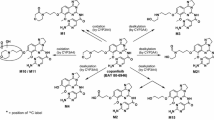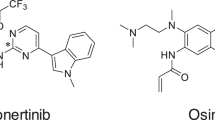Abstract
Purpose
The purpose of the study was to evaluate the metabolism, pharmacokinetics and efficacy of phospho-NSAIDs in Ces1c-knockout mice.
Methods
Hydrolysis of phospho-NSAIDs by Ces1c was investigated using Ces1c-overexpressing cells. The rate of phospho-NSAID hydrolysis was compared between wild-type, Ces1c+/− and Ces1c−/− mouse plasma in vitro, and the effect of plasma Ces1c on the cytotoxicity of phospho-NSAIDs was evaluated. Pharmacokinetics of phospho-sulindac was examined in wild-type and Ces1c−/− mice. The impact of Ces1c on the efficacy of phospho-sulindac was investigated using lung and pancreatic cancer models in vivo.
Results
Phospho-NSAIDs were extensively hydrolyzed in Ces1c-overexpressing cells. Phospho-NSAID hydrolysis in wild-type mouse plasma was 6–530-fold higher than that in the plasma of Ces1c−/− mice. Ces1c-expressing wild-type mouse serum attenuated the in vitro cytotoxicity of phospho-NSAIDs towards cancer cells. Pharmacokinetic studies of phospho-sulindac using wild-type and Ces1c−/− mice demonstrated 2-fold less inactivation of phospho-sulindac in the latter. Phospho-sulindac was 2-fold more efficacious in inhibiting the growth of lung and pancreatic carcinoma in Ces1c −/− mice, as compared to wild-type mice.
Conclusions
Our results indicate that intact phospho-NSAIDs are the pharmacologically active entities and phospho-NSAIDs are expected to be more efficacious in humans than in rodents due to their differential expression of carboxylesterases.





Similar content being viewed by others
Abbreviations
- Ces1c:
-
Mouse plasma carboxylesterase isoform 1c
- CES2:
-
Carboxylesterase 2
- COX:
-
Cyclooxygenase
- KPC:
-
Pancreatic carcinoma
- LLC:
-
Lewis lung carcinoma
- NSAID:
-
Non-steroidal anti-inflammatory drug
- PLA-PEG:
-
Polylactic acid-polyethylene glycol
- P-S:
-
Phospho-sulindac
- P-V:
-
Phospho-valproic acid
References
Clevers H. Colon cancer—understanding how NSAIDs work. New Eng J Med. 2006;354:761–3.
Scherubl H, Sutter AP, Zeitz M. NSAIDS and esophageal cancer. Gastroenterology. 2003;125:1914–5. author reply 5.
Warner TD, Giuliano F, Vojnovic I, Bukasa A, Mitchell JA, Vane JR. Nonsteroid drug selectivities for cyclo-oxygenase-1 rather than cyclo-oxygenase-2 are associated with human gastrointestinal toxicity: a full in vitro analysis. Proc Natl Acad Sci U S A. 1999;96:7563–8.
Graham DJ. COX-2 inhibitors, other NSAIDs, and cardiovascular risk - the seduction of common sense. JAMA-J Am Med Assoc. 2006;296:1653–6.
Cuzick J, Otto F, Baron JA, Brown PH, Burn J, Greenwald P, et al. Aspirin and non-steroidal anti-inflammatory drugs for cancer prevention: an international consensus statement. Lancet Oncol. 2009;10:501–7.
Nie T, Wong CC, Alston N, Aro P, Constantinides PP, Rigas B. Phospho-ibuprofen (MDC-917) incorporated in nanocarriers: anti-cancer activity in vitro and in vivo. Br J Pharmacol. 2012;166:991–1001.
Huang L, Zhu C, Sun Y, Xie G, Mackenzie GG, Qiao G, et al. Phospho-sulindac (OXT-922) inhibits the growth of human colon cancer cell lines: a redox/polyamine-dependent effect. Carcinogenesis. 2010;31:1982–90.
Mackenzie GG, Sun Y, Huang L, Xie G, Ouyang N, Gupta RC, et al. Phospho-sulindac (OXT-328), a novel sulindac derivative, is safe and effective in colon cancer prevention in mice. Gastroenterology. 2010;139:1320–32.
Huang L, Mackenzie GG, Sun Y, Ouyang N, Xie G, Vrankova K, et al. Chemotherapeutic properties of phospho-nonsteroidal anti-inflammatory drugs, a new class of anticancer compounds. Cancer Res. 2011;71:7617–27.
Zhu C, Cheng KW, Ouyang N, Huang L, Sun Y, Constantinides PP, et al. Phosphosulindac (OXT-328) selectively targets breast cancer stem cells in vitro and in human breast cancer xenografts. Stem Cells. 2012;30:2065–75.
Sun Y, Rowehl LM, Huang L, Mackenzie GG, Vrankova K, Komninou D, et al. Phospho-ibuprofen (MDC-917) suppresses breast cancer growth: an effect controlled by the thioredoxin system. Breast Cancer Res. 2012;14:R20.
Zhu R, Cheng KW, Mackenzie G, Huang L, Sun Y, Xie G, et al. Phospho-sulindac (OXT-328) inhibits the growth of human lung cancer xenografts in mice: enhanced efficacy and mitochondria targeting by its formulation in solid lipid nanoparticles. Pharm Res. 2012;29:3090–101.
Cheng KW, Mattheolabakis G, Wong CC, Ouyang N, Huang L, Constantinides PP, et al. Topical phospho-sulindac (OXT-328) is effective in the treatment of non-melanoma skin cancer. Int J Oncol. 2012;41:1199–203.
Satoh T, Hosokawa M. The mammalian carboxylesterases: from molecules to functions. Annu Rev Pharmacol Toxicol. 1998;38:257–88.
Marsha S, Xiao M, Yu J, Ahluwalia R, Minton M, Freimuth RR, et al. Pharmacogenomic assessment of carboxylesterases 1 and 2. Genomics. 2004;84:661–8.
Wong CC, Cheng KW, Xie G, Zhou D, Zhu CH, Constantinides PP, et al. Carboxylesterases 1 and 2 hydrolyze phospho-nonsteroidal anti-inflammatory drugs: relevance to their pharmacological activity. J Pharmacol Exp Ther. 2012;340:422–32.
Xie G, Nie T, Mackenzie GG, Sun Y, Huang L, Ouyang N, et al. The metabolism and pharmacokinetics of phospho-sulindac (OXT-328) and the effect of difluoromethylornithine. Br J Pharmacol. 2012;165:2152–66.
Xie G, Sun Y, Nie T, Mackenzie GG, Huang L, Kopelovich L, et al. Phospho-ibuprofen (MDC-917) is a novel agent against colon cancer: efficacy, metabolism, and pharmacokinetics in mouse models. J Pharmacol Exp Ther. 2011;337:876–86.
Li B, Sedlacek M, Manoharan I, Boopathy R, Duysen EG, Masson P, et al. Butyrylcholinesterase, paraoxonase, and albumin esterase, but not carboxylesterase, are present in human plasma. Biochem Pharmacol. 2005;70:1673–84.
Duysen EG, Koentgen F, Williams GR, Timperley CM, Schopfer LM, Cerasoli DM, et al. Production of ES1 plasma carboxylesterase knockout mice for toxicity studies. Chem Res Toxicol. 2011;24:1891–8.
Zhang Y, Huo M, Zhou J, Xie S. PKSolver: an add-in program for pharmacokinetic and pharmacodynamic data analysis in microsoft excel. Comput Methods Programs Biomed. 2010;99:306–14.
Mackenzie GG, Huang L, Alston N, Ouyang N, Vrankova K, Mattheolabakis G, et al. Targeting mitochondrial STAT3 with the novel phospho-valproic acid (MDC-1112) inhibits pancreatic cancer growth in mice. PLoS ONE. 2013;8:e61532.
Cheng KW, Wong CC, Alston N, Mackenzie GG, Huang L, Ouyang N, et al. Aerosol administration of phospho-sulindac inhibits lung tumorigenesis. Mol Cancer Ther. 2013;12:1417–28.
Khanna R, Morton CL, Danks MK, Potter PM. Proficient metabolism of irinotecan by a human intestinal carboxylesterase. Cancer Res. 2000;60:472–4728.
Humerickhouse R, Lohrbach K, Li L, Bosron WF, Dolan ME. Characterization of CPT-11 hydrolysis by human liver carboxylesterase isoforms hCE-1 and hCE-2. Cancer Res. 2000;60:1189–92.
Guichard SM, Morton CL, Krull EJ, Stewart CF, Danks MK, Potter PM. Conversion of the CPT-11 metabolite APC to SN-38 by rabbit liver carboxylesterase. Clin Cancer Res. 1998;4:3089–94.
Quinney SK, Sanghani SP, Davis WI, Hurley TD, Sun Z, Murry DJ, et al. Hydrolysis of capecitabine to 5’-deoxy-5-fluorocytidine by human carboxylesterases and inhibition by loperamide. J Pharmacol Exp Ther. 2005;313:1011–6.
Tabata T, Katoh M, Tokudome S, Nakajima M, Yokoi T. Identification of the cytosolic carboxylesterase catalyzing the 5’-deoxy-5-fluorocytidine formation from capecitabine in human liver. Drug Metab Dispos. 2004;32:1103–10.
Miwa M, Ura M, Nishida M, Sawada N, Ishikawa T, Mori K, et al. Design of a novel oral fluoropyrimidine carbamate, capecitabine, which generates 5-fluorouracil selectively in tumours by enzymes concentrated in human liver and cancer tissue. Eur J Cancer. 1998;34:1274–81.
Pratt SE, Durland-Busbice S, Shepard RL, Heinz-Taheny K, Iversen PW, Dantzig AH. Human carboxylesterase-2 hydrolyzes the prodrug of gemcitabine (LY2334737) and confers prodrug sensitivity to cancer cells. Clin Cancer Res. 2013;19:1159–68.
Morton CL, Iacono L, Hyatt JL, Taylor KR, Cheshire PJ, Houghton PJ, et al. Activation and antitumor activity of CPT-11 in plasma esterase-deficient mice. Cancer Chemother Pharm. 2005;56:629–36.
Kurumbail RG, Stevens AM, Gierse JK, McDonald JJ, Stegeman RA, Pak JY, et al. Structural basis for selective inhibition of cyclooxygenase-2 by anti-inflammatory agents. Nature. 1996;384:644–8.
Zhou D, Papayannis I, Mackenzie GG, Alston N, Ouyang N, Huang L, et al. The anticancer effect of phospho-tyrosol-indomethacin (MPI-621), a novel phosphoderivative of indomethacin: in vitro and in vivo studies. Carcinogenesis. 2012;34:943–51.
ACKNOWLEDGMENTS AND DISCLOSURES
This work was supported by the National Institutes of Health (NIH) National Cancer Institute (NCI): Grant 5R01CA154172 and the Department of Defense (DOD): Grant W81XWH 11-1-0799. Conflict of interest. The authors have nothing to disclose except for Basil Rigas, who has an equity position in Medicon Pharmaceuticals, Inc.
Author information
Authors and Affiliations
Corresponding author
Electronic supplementary material
Below is the link to the electronic supplementary material.
Supplementary Table 1
(DOC 32 kb)
Supplementary Table 2
(DOC 32 kb)
Supplementary Table 3
(DOC 32 kb)
Supplementary Figure 1
(TIFF 821 kb)

Rights and permissions
About this article
Cite this article
Wong, C.C., Cheng, KW., Papayannis, I. et al. Phospho-NSAIDs Have Enhanced Efficacy in Mice Lacking Plasma Carboxylesterase: Implications for their Clinical Pharmacology. Pharm Res 32, 1663–1675 (2015). https://doi.org/10.1007/s11095-014-1565-2
Received:
Accepted:
Published:
Issue Date:
DOI: https://doi.org/10.1007/s11095-014-1565-2




